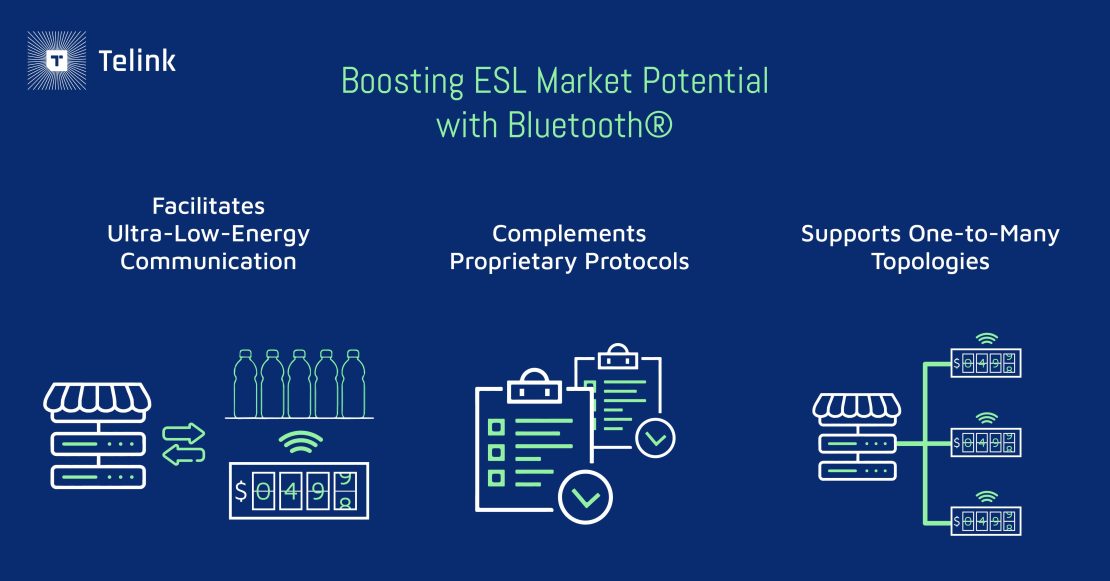



PLEASE ROTATE ME


Telink Staff
August 22, 2023
Applications

Harness the power of Bluetooth® standard protocol for an ESL system that aligns with industry demands.
The next time you go shopping, take a peek at the shelves around you — you may notice an upgrade that, while subtle, is set to elevate the consumer experience. Electronic shelf labels (ESLs) are slowly replacing paper price tags in supermarkets, retail stores, and other brick-and-mortar businesses to provide shoppers and store employees with up-to-date information on product prices, stock availability, promotional discounts, and other valuable data. Bridging the gap between traditional retail and modern technology, these digitized displays leverage wireless communication to receive data from a centralized server to associated stores, while relaying device information such as battery level and local ambient temperature.
So what are the benefits of electronic shelf labels that make these devices worth investing in? Compared to legacy paper labels, ESLs offer real-time in-store displays, updating product information as soon as changes are made to avoid informational discrepancies. In turn, this saves employees time as they no longer have to swap out labels to keep up with fluctuating prices and sales offers, nor manually update inventory throughout the day. Electronic shelf labels also allow headquarters to disseminate data across multiple branches for better price coordination and consistency, which avoids conflicts and boosts customer satisfaction.
While electronic shelf labels have been around since the 1990s, existing proprietary protocols offer a ripe opportunity for expanding the market potential of these wireless devices. According to ABI Research, 2.4 billion ESL devices are expected to be implemented in stores within the next four years. And with the advent of new Bluetooth features, ESLs are poised to achieve accelerated growth, complementing current proprietary technologies to unlock new market opportunities.

The current ESL market is largely dominated by proprietary communication protocols. ESLs require a low-power one-to-many communication topology between each shelf label and an Access Point (AP), which many vendors achieve through their own technology. However, this segmentation can cause friction and incompatibility in an IoT environment that relies on interoperability, requiring that users find expensive and time-consuming solutions to achieve the level of connectivity they need. It’s also what is hampering the widespread adoption of ESLs.
While Bluetooth® Low Energy (LE) facilitates bidirectional communication of data, it couldn’t do so at a scale that’s needed for retail applications. The latest Bluetooth features address this challenge by introducing the concept of Periodic Advertising with Responses (PAwR), enabling ultra-low-energy, bi-directional connectionless data transmission over expansive networks.
PAwR employs subevents to transmit data to devices, optimizing power consumption by enabling end nodes to scan for specific subevents within a short time frame. Bluetooth also introduces Encrypted Advertising Data to enhance data protection, catering to security needs in retail settings.
Electronic shelf label applications based on Bluetooth offer clear advantages in terms of cross-platform versatility. While the short-term hardware cost of standard Bluetooth-based ESLs may not match that of custom protocols, the economies of scale and long-term cost reduction Bluetooth can provide make it a promising choice and a future-proof investment that can help businesses adapt to industry changes as technology continues to advance.
The adoption of a standardized approach also empowers ESL vendors to focus their engineering efforts on value-added features and capabilities. It also accelerates time to market since developers don’t have to spend time developing their own custom solution to ensure that their ESL devices work within a certain proprietary environment.
With Bluetooth, retailers can enjoy the confidence and assurance that their electronic shelf labeling system will work seamlessly with other IoT devices needed to keep operations running. And with more compatible devices on the market, supplier competition will help drive prices down, making ESLs more affordable for retailers big and small.
Bluetooth makes interoperable ESL systems a reality by introducing PAwR, which supports ultra-low-energy, bidirectional connectionless data with networks that consist of one-to-many communication topologies. PAwR easily overcomes scalability challenges, accommodating a large number of devices with the ability to communicate with a single device, a specific group of devices, or all connected devices.
Encrypted Advertising Data is another feature of Bluetooth that will help catalyze the widespread adoption of ESLs, delivering standardized encryption to safeguard communication through PAwR. It aims to strengthen ESL security to prevent data manipulation, leaks, and errors.
While proprietary protocols present limitations with IoT interoperability in retail settings, they do serve a valuable purpose that Bluetooth seeks to complement, rather than replace. For example, proprietary protocols allow retailers to digitize their operations to optimize data management and streamline tasks in a way that works best for their existing software programs and applications.
Bluetooth expands compatibility and interoperability, paving the way for diverse players in the ESL market and generating supplier competition. Here’s how proprietary protocols and Bluetooth standard protocol uniquely address different ESL market segments:
| Features | Proprietary Protocol | Bluetooth Standard Protocol |
| Power consumption | Highly optimized | Less optimized than proprietary solution |
| Hardware cost | Highly optimized | The short-term cost is not the lowest, but the long-term cost may be the best due to economy of scale and competition |
| Degree of product differentiation | High | Medium |
| Cross-platform interoperability | Weak | Strong |
| Supply chain selection | Limit | Flexible |
| Ability to connect with other IoT devices/applications | Weak | Strong |
| Suitable ESL equipment manufacturers | Leading manufacturers with comprehensive development capabilities | Small, medium-sized, and new manufacturers |
| Does Telink support it? | Yes | Yes |
By complementing proprietary protocols and promoting standardization, Bluetooth unlocks a new era of possibilities for the electronic shelf label market. This evolution translates into enhanced retail operations, improved customer experiences, and a more interconnected retail ecosystem. As the market continues to evolve, the seamless connectivity offered by Bluetooth and the ESL industry’s innovation potential promise a future where modern technology is seamlessly integrated into every retail shelf.
In the landscape of ESL innovation, Telink has emerged as a prominent player since 2017. With our focus on low power consumption, high RF performance, and integrated chip technology, Telink has earned recognition in the electronic shelf label market with our state-of-the-art SoCs. Our diversified semiconductor chips support both custom protocols and Bluetooth standard protocol, providing flexibility and diversity in ESL device development. For those creating proprietary ESL systems, the option of Telink’s TLSR835x SoC is available, while those seeking a standard Bluetooth solution can opt for our cutting-edge TLSR9 series SoC.
Contact us today or send emails directly to telinksales@telink-semi.com to learn more about how Telink can help you claim your space in the booming ESL market.